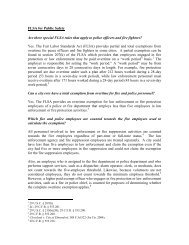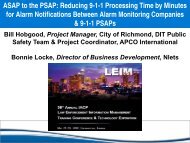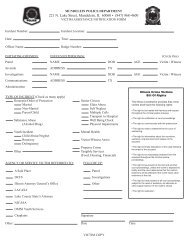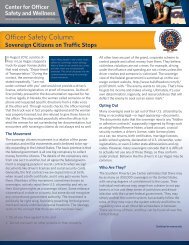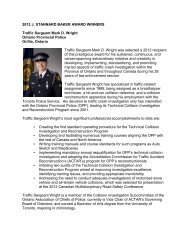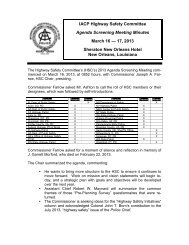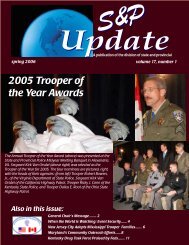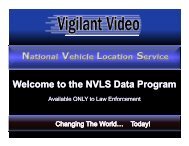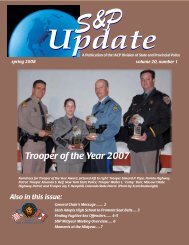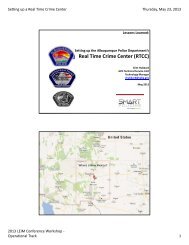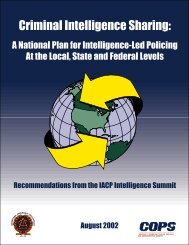Unified Computer-Aided Dispatch Functional Requirements ...
Unified Computer-Aided Dispatch Functional Requirements ...
Unified Computer-Aided Dispatch Functional Requirements ...
Create successful ePaper yourself
Turn your PDF publications into a flip-book with our unique Google optimized e-Paper software.
<strong>Unified</strong> <strong>Computer</strong>-<strong>Aided</strong> <strong>Dispatch</strong> <strong>Functional</strong><br />
<strong>Requirements</strong> (UCADFR): Its Use and Future<br />
Bill Hobgood, Project Manager, City of Richmond, DIT Public Safety Team<br />
& Project Coordinator, APCO International<br />
Mike Roosa, Chief Information Officer, Maryland State Police<br />
Dave Roberts, Senior Program Manager, International Association of Chiefs of Police<br />
1<br />
May 22, 2012
� PSDI Projects Background<br />
� Current UCAD Deliverables<br />
� UCADFR<br />
� Why a Standard?<br />
� The Development Process<br />
� A Look at the Draft Standard<br />
� Other Project Deliverables<br />
� Future Projects<br />
Agenda
PSDI Program Purpose<br />
� To advance information exchange within the<br />
local communication center and first<br />
responder communities<br />
� Emergency Communications<br />
� Law Enforcement<br />
� Fire<br />
� EMS<br />
� Emergency Management<br />
� Transportation<br />
� Others
2003‐2006, LEITSC (IACP, NOBLE, NSA, PERF)<br />
PSDI Projects<br />
Standard <strong>Functional</strong> Specifications for Law Enforcement CAD and<br />
RMS Systems
2005‐2009, IJIS Institute<br />
PSDI Projects<br />
Intelligent Transportation Systems / Public Safety Information<br />
Exchange Project (ITS/PS)<br />
Laboratory Validation; Pilot; Outreach; NISS Readiness;<br />
Lessons Learned; Project Recommendations<br />
12 Exchanges
2007‐2010, IJIS Institute & APCO<br />
Public Safety Data Interoperability (PSDI)<br />
ASAP Exchange<br />
Upgrade<br />
(NIEM)<br />
Outreach; Lessons Learned; Project<br />
Recommendations<br />
PSDI Projects
In 2010, the IJIS Institute<br />
& APCO submitted a<br />
proposal to BJA for the<br />
<strong>Unified</strong> CAD<br />
Specifications Project<br />
… it was awarded in<br />
September 2010.<br />
Funding Proposal<br />
PSDI’s<br />
Revision Assessment<br />
LEITSC’s<br />
CAD <strong>Functional</strong><br />
Specifications<br />
<strong>Unified</strong> CAD<br />
<strong>Functional</strong><br />
<strong>Requirements</strong><br />
(UCADFR)
2010‐2012, IJIS Institute & APCO<br />
<strong>Unified</strong> CAD Specifications Project (UCAD)<br />
BJA Grant # 2010-DB-BX-K147<br />
ASAP Exchange<br />
Upgrade<br />
(Video)<br />
Outreach; APCO ANS Process for UCADFR;<br />
Lessons Learned; Project Recommendations<br />
PSDI Projects
Industry<br />
� James Dundas, Northrup Grumman<br />
� Matthew Schreiner, Motorola<br />
� Henry Unger, Hitech Systems, Inc.<br />
Communications<br />
� Peggy Fouts, Grays Harbor Comm., WA<br />
� Jerry Schlesinger, City of Portland, OR<br />
� Lance Terry, City of Norman, OK<br />
EMS<br />
� Karen Jacobson, NEMSIS<br />
� Chris Kummer, Hennepin EMS, MN<br />
� Greg Mears, MD, NC EMS & Univ. of NC<br />
UCAD Project ‐ Detail<br />
Fire Services<br />
� Evan Bestland, Palm Beach Co. Fire Rescue, FL<br />
� Donald Bowers, Fairfax Co. Fire & Rescue, VA<br />
� Daniel Stilwell, Seattle Fire Department, WA<br />
� Dennis Wood, Prince George’s Co. Fire/EMS,<br />
MD<br />
Law Enforcement<br />
� Bret Crook, City of Woodway TX<br />
� Norine Plett, LA Co. Sheriff, CA<br />
� Dave Roberts, IACP<br />
� Mike Roosa, Maryland State Police<br />
Project Management Team<br />
� Bill Hobgood, APCO & City of Richmond VA<br />
� Paul Holcombe, IJIS Institute<br />
� Randy Kent, IJIS Institute<br />
� Scott Parker, IJIS Institute<br />
� Chris Traver, Bureau of Justice Assistance<br />
� Steve Wisely, APCO
Status of UCADFR<br />
APCO ANS<br />
Maintenance<br />
Publish<br />
APCO ANS Process / Public Review<br />
BJA Approval<br />
Final Review (Project)<br />
Final Review (Project)<br />
Feedback Reconciliation<br />
External Review (29 Orgs)<br />
Edited and Filled in Gaps<br />
Formed 3 work groups<br />
Solidified Function List<br />
Format & changed to “<strong>Functional</strong> <strong>Requirements</strong>”<br />
Adoption of LEITSC CAD <strong>Functional</strong> Specifications & PSDI Revision Assessment
– American Ambulance Association (AAA)<br />
External Review: Requested Organizations<br />
(representative sample)<br />
– Association of Public‐Safety Communications Officials‐International (APCO)<br />
– IJIS Institute’s IJIS Public Safety Technology Standards Committee (IPSTSC)<br />
– International Association of Chiefs of Police (IACP)<br />
– International Association of Emergency Medical Service Chiefs (IAEMSC)<br />
– International Association of Fire Chiefs (IAFC)<br />
– International Association of Fire Fighters (IAFF)<br />
– Major City Chiefs (MCC)<br />
– National Association of State EMS Officials (NASEMSO)<br />
– National Emergency Number Association (NENA)<br />
– National Fire Protection Association (NFPA)<br />
– National Organization of Black Law Enforcement Executives (NOBLE)<br />
– National Sheriff’s Association (NSA)<br />
– Police Executive Research Forum (PERF)
A Look at the Draft<br />
UCADFR Document
The UCADFR, once made<br />
into an American National<br />
Standard, will standardize a<br />
“Master List” of CAD<br />
Functions … as a reference<br />
for Practitioners and<br />
Industry.<br />
The UCADFR will NOT<br />
standardize which functions<br />
need/should be in a CAD<br />
System!<br />
What are we standardizing?
<strong>Requirements</strong> from the <strong>Functional</strong><br />
Specifications for Law Enforcement<br />
<strong>Computer</strong> <strong>Aided</strong> <strong>Dispatch</strong> (CAD) Systems<br />
Relevance Matrix (LEITSC)<br />
Law Enforcement Fire EMS<br />
Business Function: Law Enforcement <strong>Dispatch</strong><br />
Call Taking X X X<br />
<strong>Dispatch</strong> Decision Support X X X<br />
BOLO X<br />
<strong>Dispatch</strong> Units X X X<br />
Unit Status Management X X X<br />
Call Management X X X<br />
Supplemental Resources Tracking X X X<br />
Call Disposition X X X<br />
Business Function: CAD System Administration<br />
Geofile Maintenance X X X<br />
Security X X X<br />
Logging X X X<br />
Configuration X X X<br />
Table Maintenance X X X<br />
Communication Center Relocation X X X<br />
CAD Catch‐Up X X X<br />
Business Function: Support Services<br />
BOLO X<br />
Emergency Operations Center X X X<br />
Business Function: Call Management and Management Reporting<br />
<strong>Dispatch</strong> Supervisor Support X X X<br />
CAD Management Reporting X X X<br />
Training and Testing X X X<br />
Business Function: Interfaces<br />
Primary X X X<br />
Additional Interfaces X X X<br />
Locational Systems Interfaces X X X<br />
Administration Interfaces X X X<br />
Communications Interfaces X X X<br />
Public Awareness Messaging X X X<br />
Emergency Operations Interface X X X<br />
Additional Business Functions X X X
REQUIREMENTS FROM THE REVISION<br />
ASSESSMENT FOR THE INCORPORATION OF FIRE<br />
AND EMS FUNCTIONS INTO THE LAW<br />
ENFORCEMENT CAD FUNCTIONAL SPECIFICATIONS<br />
Relevance Matrix (Revision)<br />
Law Enforcement Fire EMS<br />
Add Destination Locations X X X<br />
Alerting X X<br />
Move Up (“Fill‐In” and “Station Fill”) X X<br />
Staffed versus Unstaffed Units X X<br />
Cross‐Staffing/Crew Counting/Shared Staffing X X<br />
System Status Management (Dynamic Resource Deployment) X<br />
Station <strong>Dispatch</strong> (versus Unit <strong>Dispatch</strong>) X X<br />
Run Cards/Response Plans X X<br />
Adjustable <strong>Dispatch</strong> Levels X X<br />
Adjustable Response Plans X X<br />
Hospital Status/Availability and Hospital Recommendation X X<br />
Additional Attributes X X X<br />
CAD Incident Type X X X<br />
Unit Recommendation Based on Input from Other Jurisdictions X X<br />
Predetermined and User Defined Timers X X X<br />
Unit Status Timers X X X<br />
Patient Tracking X X X<br />
Additional Unit Status X X X<br />
Strike Team/Task Force Designations X X X<br />
Unit Rotation (aka Unit Load Balancing) X X X<br />
Conditional Availability of Apparatus X X X<br />
Ability to Route to a “Decision <strong>Dispatch</strong>er” X<br />
Linking an Audio File to the CAD <strong>Dispatch</strong> Record X X X<br />
Rostering X X X<br />
Mileage Tracking X X X<br />
Hydrant Location and Status X<br />
Additional Unit Dispositions X X X<br />
Exception Reason Tracking X X X<br />
Add Next Generation Functions X X X<br />
Multiple Simultaneous Calls to Single Unit X X X
Relevance Matrix (Revision‐Cont’d)<br />
Law Enforcement Fire EMS<br />
Notifications X X X<br />
Contact List X X X<br />
Scheduled Events X X X<br />
Special <strong>Dispatch</strong> Areas X X X<br />
EMD/Call Triage X X X<br />
Premises Information/Hazards X X X<br />
Public Safety Flight Tracking X X X<br />
Channel Designations X X X<br />
Suspicious Activity Reporting <strong>Functional</strong>ity X<br />
Geo‐fencing X X X<br />
Communications Center Standard Operating Procedures X X X<br />
Incident/Premises/Unit Standard Operating Procedures X X X<br />
Snapshot/Incident Replay X X X<br />
Pre‐Release or Pre‐Alerting X X X<br />
Remote Access X X X<br />
Integration/Interfaces with Other Systems X X X<br />
CAD Workstation‐to‐CAD Workstation Messaging X X X<br />
Secondary Incident Location X X X<br />
Vehicle/Unit Change X X X<br />
Automatic Routing X X X<br />
Scheduling X X X<br />
Incident Command Support X X X<br />
Single Discipline Call to a Combined Discipline Call X X X<br />
Narrative Field “Shorthand” (Auto Text) X X X<br />
Command Line/GUI X X X<br />
Time Stamps X X X<br />
Bypassed Units X X X<br />
Post <strong>Dispatch</strong> Response Re‐evaluation X X X<br />
Unit Status Transition Matrix X X X
A Look at the Draft UCADFR Document –<br />
Example Function #1
A Look at the Draft UCADFR Document –<br />
Example Function #1
A Look at the Draft UCADFR Document<br />
‐ Example: Function #2
Other Potential Future <strong>Unified</strong><br />
Initiatives<br />
1) <strong>Unified</strong> RMS <strong>Functional</strong> <strong>Requirements</strong> / Standard<br />
2) <strong>Unified</strong> Mobile Computing <strong>Functional</strong><br />
<strong>Requirements</strong> / Standard<br />
– <strong>Unified</strong> Field Reporting<br />
– Field Interview<br />
– Automated Accident Reporting<br />
– UCR/NIBRS (Uniform Crime Reporting/National Incident Based Reporting<br />
System)<br />
– ePCR (Electronic Patient Care Reporting)<br />
– NFIRS (National Fire Incident Reporting System)<br />
– Inspection/Permitting<br />
3) APIs for LTE<br />
4) NG9‐1‐1 EIDD ‐ Emergency Information Data<br />
Document<br />
5) ASAP –Automated Secure Alarm Protocol<br />
(was External Alarm Interface)
Questions?<br />
Bill Hobgood, Co‐Project Manager, UCAD Project<br />
APCO International: hobgoodb@apcointl.org<br />
(804) 646‐5140



